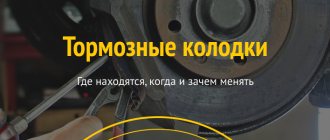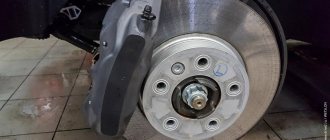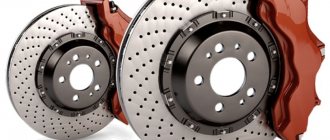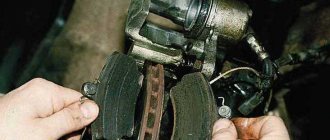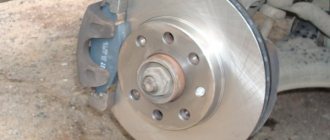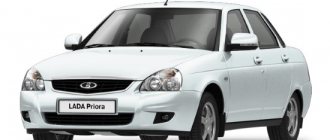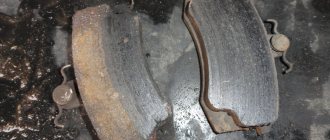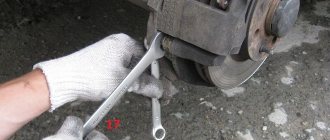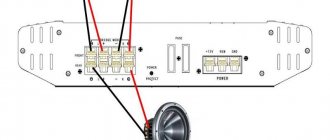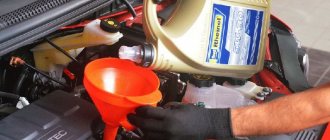Regardless of the year of manufacture and modification, the VAZ 2110 is equipped with the same front disc and rear drum brake pads. VAZ cars are equipped similarly: 2108, 2109, 21099, 2110-11, 2110-12.
The first thing you should pay attention to when choosing is your driving style. If you prefer a relaxed driving style, then you will be satisfied with pads with low abrasive properties, but at the same time, a disc that costs much more will last longer. And if you prefer a dynamic driving style, then you can afford pads with hard linings, but the wear of both the pads and the disc will be much greater. For more details about the properties, see the note column.
When to change brake pads on a VAZ 2110: instructions and useful tips
Front pads for a VAZ 2110
It turns out that not every motorist, even an experienced one, knows when to change the brake pads of a VAZ 2110. Some say it needs to be changed often, others say rarely. But this approach to the issue is fundamentally wrong, since it all depends on the driving style, the brand of pads and much more. So, when to change brake pads on a VAZ 2110?
Replacing brake pads VAZ 2110
How to choose
When replacing, it is important to install high-quality brake pads that are fully compatible with your car. To do this, you can ask for help at a service station or a spare parts store. Today there is a good selection in different price categories, from the original to alternative manufacturers. In general, please pay attention to the following points before installation:
- The friction material has a uniform color and does not contain foreign inclusions;
- The surface is smooth without defects or defects (small chips along the edges are allowed);
- The surface where the friction material is attached to the metal has no cracks.
We also do not recommend basing your choice on price alone, as it may be due to low-quality friction material, which will lead to rapid abrasion.
Pad wear
There is, as a rule, a standard service life of the pads, which is 10 thousand km. But again, everything is transparent. In principle, when always buying brake pads, you should be careful and pay attention to the service life of these parts. As a rule, no manufacturer is able to provide accurate information about the service life of the pads. What does it mean? And the fact is that you need to monitor the wear of the pads, and only then draw conclusions.
Replacing brake pads on a VAZ 2110
Each type of brake pad has a concept called acceptable wear. So, for almost all pads it is no more than 85 percent. In other words, if it is noticed that the pads are worn out by more than three quarters, they need to be replaced with new ones. You can say it another way: the thickness of the brake pads should be more than 1.5 mm. If the thickness is less, then there is a possibility of damaging the pistons of the master cylinder when braking, and this will not lead to anything good. The front brake pads, as a rule, are different from the rear ones. We are talking, again, about wear and tear. Rear brake pads are more durable and can work effectively not for 10 thousand kilometers, but for all 60 thousand kilometers. Well, again, it all depends on the degree of wear, driving style, etc. As for the degree of wear, here, like the front ones, it is at least 1.5 mm.
Note. Today, brake pads are known that are equipped with a special wear indicator. The essence of this technology is that a built-in metal plate, which rubs against the disc when excessive wear occurs, thus gives a signal that it is time to change the pads.
What factors influence wear?
The wear of brake system components depends on many factors:
- poor quality material used by the manufacturer;
- installation of any element: pad, disc or drum was previously carried out incorrectly;
- aggressive driving style of the car owner.
The reasons listed apply to all parts of the brake system. We’ll tell you how you can avoid such factors and significantly increase their service life.
Important! It is necessary to purchase parts from trusted manufacturers.
There are plenty of counterfeit goods on the market. The cheap cost of the product should indicate to the car enthusiast that the spare part can be made from low-grade raw materials. In this case, you won’t be able to save money: its service life may quickly end.
How to check pad wear
To independently check the degree of wear of the pads on a VAZ 2110 car, you should follow the process described below.
Front pads
- wheels are removed;
- the disk is cleaned of dust and dirt;
- a caliper is taken and the thickness is measured.
Note. Like pads, discs must have a certain level of wear. As a rule, the permissible wear of discs is 10.8 mm and no smaller. If the disc is too worn, it needs to be replaced.
- A visual inspection of the brake pads is carried out.
How to check pad wear
Note. You can determine the condition of the brake pads by looking through special holes designed for this purpose. As mentioned above, their thickness should not be less than 1.5 mm.
- The ease of movement of the pads is also checked.
Note. The ease of movement of the pads is checked with a screwdriver. If the pads are difficult to move, then it is likely that they are pinching the disc. You will have to replace the disc or caliper.
Rear pads
In order to check the brake pads at the rear, you should do the same, only after removing the wheels, you also need to remove the drum. Drum wear must also be measured. To do this you should:
- measure the diameter of the working surface of the drum.
Note. You should know that the maximum permissible wear should not exceed 201.5 mm in this case.
The following are situations when it is necessary to replace brake pads:
- if the thickness of the pads is less than one and a half millimeters;
- if the friction linings of the pads have traces of oil on the surface;
- if there is a poor connection of the linings with the base;
- if you hear a characteristic creaking noise when braking;
- if there is a beat when pressing the brake pedal.
When do you need to replace the pads and how to determine the degree of their wear?
The service life of the pads on VAZ-2110 cars and its derivative modifications is, on average, 15–20 thousand kilometers for the front ones, and 40–50 thousand for the rear ones.
However, their wear directly depends on a number of factors.
Thus, during city driving, the degree of wear is higher, as well as when operating on dusty roads, when there is a high risk of mechanical particles getting on the working surfaces.
The main sign of a malfunction is the appearance of a characteristic whistle during braking. This is due to the fact that the pad design contains signal indicator strips, and when the working surface of the pad wears down to a critical minimum, the strips are exposed and create this sound.
Along with this, problems can be expressed in the form of a metallic grinding sound in the event of destruction of the friction layer and exposure of the metal structure of the pad.
In this case, during the braking stage, vibrations and knocks may appear, as well as a characteristic creaking sound in the area of the front wheel (or the rear wheel if the rear pads become unusable).
In other words, the pads whistle, rattle or knock, indicating a malfunction.
Difference in thickness of old and new pads
Necessary tools to change parts
Changing the brake pads on a VAZ-2110 on your own is not difficult if you have basic skills. For this you will need:
- keys for 13 and 17,
- regular wire cutters
- jack for raising a car.
If the rear pads are being replaced, the kit should include:
- 7" head with knob,
- pliers,
- head “30” in case there are difficulties in removing the drum.
The process of replacing front brake pads on VAZ 2110, 2111, 2112
Replacing the front pads on cars of the “tenth” family is quite simple. To do this you need:
- Jack up the car and remove the front wheel.
- Bend the locking plate to gain access to the bolt and unscrew it, installing the keys “17” inside and “13” on top.
Bend the locking plateUnscrew the lower mounting bolt
- Unscrew the bolt located on the caliper and remove it along with the plate.
Removing the bolt and plate - Pry off the caliper and then open it.
Pry the caliper with a screwdriver to open it - Remove the brake pads.
Removing worn out brake pads - Using a wrench, press the brake cylinder into the caliper body and cut the wire responsible for indicating pad wear.
Cutting the wire - Disconnect the connector and remove the remaining wire.
Disconnect the connectorWe take out the wire
- Connect the new connector and wire.
- Reassemble in reverse order.
- After completing the work, press the brake pedal several times to restore the working efficiency of the braking system.
The work process takes about 30 minutes for one wheel and can be completed with minimal knowledge in the field of auto repair.
How to replace the rear ones
Replacing rear pads on VAZ-2110 series cars and their derivatives is somewhat more difficult, since they are of the drum type. Replacement work is carried out as follows:
- The rear of the car is jacked up, after which the wheel is removed.
- The guide pins located on the drum are unscrewed (if the pins become soured, it is possible to remove the drum along with the hub after unscrewing it).
The work is carried out with a 12 key - If the drum cannot be dismantled, tap it. It is better to tap through a wooden spacer
or using a mounting spatula - Using long-nose pliers, remove the cotter pin located on the left side.
- Using pliers, disconnect the spring that tightens the brake pads at the bottom. Pry up the spring
... and take it out - The fastening side springs are removed (steps 1–4), the spacer bar (5), after which the pads are removed from the drum body (6 and 7). Step 7 Step 6 Step 5 Step 4 Step 3 Step 2 Step 1
- Installation of the pads is carried out in reverse order.
Troubleshooting possible replacement problems
There are relatively few difficulties when replacing brake pads. As a rule, they are associated with souring of bolts due to rust. The drum elements most susceptible to corrosion are the mounting pins. In case of possible difficulties, the drum is removed along with the rear wheel hub, and when unscrewing the studs, it is allowed to use a penetrating lubricant such as WD-40.
However, when working with brake mechanisms, lubricants should be used extremely carefully, avoiding their contact with the working surface of the pads or disc (in the case of the front wheels). Otherwise, the efficiency of the brakes can be significantly reduced, up to severe slipping between the working surfaces of the pad and the drum linings or the disc.
To summarize, we can note the ease of replacing brake pads on a VAZ-2110. The procedure does not require special skills or tools; it can be done in an ordinary garage without any particular difficulties. Knowing the order of operations when replacing allows you to complete this procedure quickly and efficiently.
Source: https://carnovato.ru/kak-pomenyat-kolodki-na-vaz-2110-2111-i-2112/
Replacing front brake pads
Replacing brake pads VAZ 2110
Before you start replacing the front brake pads of the VAZ 2110, you need to prepare the car. Started:
- hang out the wheel;
- remove it;
- Now you will need to bend the edges of the locking plate of the lower bolt that secures the wheel cylinder to the guide pin.
note
When replacing rear brake pads on a VAZ-2110, other difficulties may arise (for example, dirty cylinders in the drum). Do not use gasoline, kerosene or other mineral solvents to clean them. Use only specialized products that are sold in spray form. The product is called “Brake Cleaner”. Judging by the reviews, products from TRW have proven themselves well.
Also note that the pads are replaced in pairs on both wheels. This way you will eliminate problems with the effectiveness of the handbrake and the operation of the system as a whole. In total, you will need 4 pads to replace (two on each side). Their cost for the “ten” is small - about 500-700 rubles per set. As for manufacturers, many motorists recommend installing pads from NIPPON (Japan).
We change the rear brake pads on a VAZ 2110 with our own hands
To find out when it is necessary to replace the rear brake pads of a VAZ 2110, you should focus not only on your own sensations or the appearance of squeaks when braking, but also on their actual wear.
You can assess the condition of the pads through the inspection window without even removing the drum. To do this, remove the rubber plug in the dust shield, pry it off with a screwdriver, and look at the pads. Their thickness should be more than 1.5 mm.
If it is less, then they will no longer provide a quick stop after pressing the pedal. In addition, with such a thickness, the piston stroke of the cylinder will be greater than normal. Hence, leaks leading to loss of fluid, a drop in its pressure, that is, the entire braking system is at risk.
Order of Operations
Compared to repairing the front pair on the above VAZ models, working with the rear elements is more difficult, since they have a drum structure. To ensure ease of operation, you need to place the machine on a level floor and jack up the rear part.
- First the wheel is removed. Behind it there is access to the dirty drum. It is necessary to completely loosen the handbrake cable, otherwise there will be problems with dismantling.
- The studs on the brake drum are loosening. If they are heavily oxidized, you can remove the part together with the hub; to do this, you also need to unscrew it.
First you need to try to remove the drum. If that doesn’t work, you can coat the acidified areas with a brake or aerosol compound. This will increase the repair time, but will make the work easier. Then tap the part with a hammer through a mounting blade or wooden block.
- You need to clean the shield from dirt. The condition of the linings should be assessed. Manufacturers recommend replacing them with a thickness of one and a half millimeters, but practice shows that it is advisable to use new ones even with a thickness of 3 millimeters.
- The new part is now being installed. But first you need to completely clamp the cylinder piston, otherwise the drum simply will not install.
New pads are mounted, the rod is pinned, the spring is installed with a screwdriver. Care must be taken to ensure that the cable housing does not come into contact with moving parts.See the order of events in this video:
Device
Before disassembling, you need to know the structure of the braking system. The VAZ 2110 has hydraulic brakes with distributed circuits. One circuit is the front right and rear left mechanisms, the second circuit is diagonal.
The hydraulic drive includes a (also dual-circuit) pressure regulator. It helps regulate the brake fluid pressure on the rear brake systems. It is through the regulator that the fluid flows to both rear mechanisms.
Adjustment is carried out through four chambers. Their design is as follows: two are connected to the main cylinder, and two, respectively, to both cylinders of the rear brakes.
For high-quality braking, it is necessary that the entire system works smoothly, there is correct adjustment and reliable mechanisms.
Required spare parts
Just 10 years ago, old pads were not replaced; they were glued on, linings were changed, or they were riveted. Today on the market you can easily purchase the entire mechanism. To replace, you need to prepare new pads. Experts believe that it is better to install replacement factory parts, article number 2110-3501080-60 (TIIR-260), 21100350180082 or 2110-3501080. There are other opinions. Some motorists believe that pads from well-known brands provide the best braking parameters on the VAZ 2110, 2111, 2112. These are parts from brands such as Brembo, ABS, Ferodo, TRW, Bosch, Optimal or Delphi.
Parsing order
It is better to carry out the repair operation on an overpass (you can use an inspection hole), or just a flat area with a hard surface, because you will have to remove the rear wheels, naturally, first jacking up the car.
- Remove the wheel and disk;
- We unscrew the guide bolts, of which there are 2, and remove the drum;
- A common problem is the drum sticking, so sometimes it is not so easy to remove it. The problem has long been solved by tapping a drum with a hammer (through a board);
- Using pliers, remove the tension spring;
- After this, a fixing guide spring holding the block;
- We remove the block from the support bar that is not connected to the handbrake rod. To do this, pull its free edge to the side and along the shield;
- Loosen the upper spring. To do this, you need to turn the block to the side until you can disconnect the spring;
- We do the same with the spring of the second pad;
- Remove the spacer bar;
- Disconnect the handbrake rod from the cable;
- We note to ourselves or sketch how the connection to the rod is made;
- Unhook the spring, remove the cotter pin, and disconnect the brake pad.
Thus, the disassembly process is completed.
Main features
There are several symptoms by which you can determine the wear of these elements:
- Increased brake pedal travel. It becomes softer and only grips at the end. This reduces the braking efficiency of the vehicle. This significantly affects traffic safety. Similar symptoms can occur with brake fluid leaks. But if its level is in order, and there are no drips on the tubes and connections, then the rear brake pads on the VAZ-2110 need to be replaced.
- Increased travel of the parking brake lever. If the pedal can be soft even if the front pads are worn out, then a weak handbrake indicates wear on the rear ones. How to determine whether the lever stroke in a car is normal? To do this, place the car on an inclined surface (at least ten degrees) and tighten the handbrake. If the car rolls down, it means the cable is loose or the rear pads are worn out. You can also count the number of clicks on the lever. In normal condition there should be 3-4. If there are 5 or more of them, then you need to replace the rear brake pads on a VAZ-2110.
- Characteristic creaking noise when braking. Subsequently, it can develop into vibration. In this case, the friction material is completely worn out, and the lining is in contact with the drum mechanism with bare metal. Driving with such a symptom is extremely dangerous. At one point, the pads can simply jam, not to mention the crazy wear caused by metal-to-metal friction.
- Minimum thickness of friction material. Unlike previous cases, this can only be found out by removing the drum cover. Experts note that the thickness of the friction material on the rear drum mechanisms of the “tens” should be at least one and a half millimeters.
Replacement
In principle, assembly occurs in the reverse order, although there are some peculiarities:
- To achieve normal brake fluid pressure, in the future, it is necessary to drive the piston of the brake cylinder inside;
- Connect the handbrake rod and the block, be sure to insert the cotter pin;
- Connect the guide spring to the brake pad;
- Connect the cable to the handbrake rod;
- Connect the upper spring to the installed new block;
- You need to rest the second shoe on the heel of the brake cylinder and pull its lower edge. The spring is tensioned, the bar can be inserted;
- All that remains is to insert the second block and place it in the slot of the bar;
- Using pliers, engage the spring with the second block;
- After making sure that the cable does not get affected by the movement of the parts that make up the brake mechanism, it is necessary to install the brake drum in place;
- All that remains is to tighten the guide bolts, then install the wheel.
We do the same with the other wheel.
The principle of operation of the braking system
We consider the operating principle using the example of our hydraulic system with drum brakes:
- By pressing the brake pedal, we transfer the load to the booster, this booster creates additional force through the master cylinder
- In this case, the piston of the master cylinder forces (pumps) fluid through pipelines (pipes and brake hoses) to the wheel cylinders
- This increases the brake fluid pressure in the brake drive.
- From this, the pistons of the wheel cylinders move (press) the brake pads to the drums (or discs, if the brakes are disc)
- Further pressing of the pedal increases fluid pressure and triggers the brakes.
- The mechanisms lead to a slowdown in wheel rotation and the formation of braking forces when the tires come into contact with the road
- The more force we apply to the brake pedal, the more effective the braking is.
- When braking, the brake fluid pressure reaches 10-15 Megapascals
- When braking is completed (and the brake pedal is released), it is moved by the return spring to its initial position
- The piston of the brake master cylinder also returns to its initial position.
- Spring mechanisms (elements) pull back the drum (disc) pads
- In this case, the brake fluid from the wheel cylinders through hoses and pipelines is forced into the reservoir of the master brake cylinder
- Pressure drops in the brake system
Tools
Replacing the rear pads of a VAZ 2112 cannot be done without the necessary tools:
- Two screwdrivers, flat (slotted) and Phillips
- Jack
- Balloon wrench
- Pliers and needle nose pliers (pliers with thin and long jaws)
- Deep head 7 with extension and wrench or ratchet
- A 30 head with a strong wrench may come in handy (if you suddenly fail to remove the brake drum)
- Wire brush
Adjusting the pressure
First, you need to adjust the parking brake. This device always requires adjustment after repair work.
Secondly, the rear brakes are adjusted so that the system locks the rear wheels a little later than the front ones.
Knowing the structure of the brakes, loosen the bolt securing the pressure regulator, using a screwdriver, move the bracket of the regulator drive lever to create a gap of about 2 mm between the lever and its spring.
We carry out a test - we accelerate the car to 40 kilometers, then sharply brake. Someone observing the process from the outside notes whether the wheels are locked correctly. If the front wheels lock later than the rear ones, then the adjuster must be moved in the direction of decreasing the gap. Then test again until correct wheel locking is achieved.
Installation
Now we take a set of new friction linings out of the box and put them in place. We will need to install the cotter pin and drive arm pin support washer. The upper ends of the pads must fit exactly into the grooves of the piston. The slightest distortions are excluded. To bring the pads together, you need to move the piston to the center of the cylinder. To do this, you can use a mount. To finally bring the pads to the drum, press the brake pedal two or three times. Further assembly is carried out in reverse order. If the pads are difficult to get in, your handbrake cable may be too tight. It needs to be loosened and then adjusted. How to do it? We will talk about this below.
Replacing the rear brake pads of a VAZ 2110. Step-by-step instructions
Minimum permissible thickness of friction linings for VAZ 2110 brake pads
-1.5 mm. Replace the pads in the following cases:
- the thickness of the friction linings is less than the permissible value;
-the surface of the linings is oily;
-friction lining
not firmly connected to the base;
- deep grooves and chips have formed on the linings.
You will need: a 12" wrench, a flat-blade screwdriver, a mounting spatula, a hammer, pliers or a bit for removing the tension springs.
1. Engage first gear and install thrust blocks under the front wheels.
2. Make sure that the parking brake lever is lowered all the way down (the car is released).
3.Remove the wheel and clean the brake mechanism from dirt.
4.If the brake fluid level in the master cylinder
is at the “MAX” mark or is approaching it, pump out some of the liquid from the reservoir. Otherwise, when replacing the pads, it may splash out.
5.Remove the brake drum.
6.Remove the upper tension spring with a punch or pliers.
7.Remove the lower tension spring in the same way.
8.Remove the front pad guide spring and then the front pad.
9.Remove the expansion bar.
10.Remove the rear shoe guide spring and then the rear shoe by disconnecting the drive arm from the parking brake cable end.
11.Remove the cotter pin and the support washer from the pin of the rear shoe
.
12.Press the pin and remove the drive lever from the block. Remove your finger from the block.
VAZ 2112: replacing rear pads at home
Set of VAZ rear brake pads
On VAZ cars, the rear brake pads wear out much more slowly than the front ones. Their service life under standard operating conditions and high-quality linings is up to 50 thousand kilometers, after which their braking efficiency decreases, while the hand (parking) brake weakens, which signals the need to replace the rear pads of the VAZ 2112. This task is feasible for everyone and can be easily solved at home (or garage) conditions, done with your own hands, does not require scarce tools and the skills of a professional auto repairman.
We change the rear brake pads on a VAZ-2110 and choose which ones are better
The load on the rear brakes during braking is much less than on the front . However, this does not eliminate the need to monitor the rear brake mechanism. The VAZ tenth family is no exception. Replacement of rear brake pads on a VAZ-2110 is carried out as they wear out , and when, how and which pads are best to choose, we’ll figure it out together.
This is worth paying special attention to
Replacing rear pads on a VAZ 2112 has its own characteristics, without knowledge of which you can add unnecessary work and unnecessary problems to yourself:
- Loosen and tighten the wheel bolts only when the vehicle is on the ground. The instructions specify bolt tightening torques of 65–95 Newtons per meter (which corresponds to 6.5–9.5 kilograms of force per meter)
- The use of gasoline, diesel fuel or any mineral solvents for washing brakes (drums, pads, etc.) is not allowed, in order to avoid problems
- When installing old pads back, it is not allowed to replace the rear and front pads with each other, as well as to move them from the right to the left wheel. Such a rearrangement will lead to uneven braking.
- Brake pad sets must be replaced on both sides of the car at once.
- Check the fluid level in the brake reservoir; if it reaches or is very close to it, you need to pump out some of the fluid using a syringe. Otherwise, the brake fluid will overflow when you install new pads.
When to change the rear brake pads on a VAZ-2110
According to technical regulations, replacement of the rear pads should be carried out when the thickness of the friction linings approaches the critical level of 1.5–2 mm.
It is impossible to measure the thickness of the linings without disassembling the brake mechanism, but in this case the handbrake will help. If, when tightening the handbrake, the equalizer nut rests against the end of the rod, but the wheels are still far from being completely locked, and the wheels are not blocked when the handbrake is fully tightened, most likely the pads have worn out to the limit.
Knocks and squeaks
In addition, knocking in the rear brake mechanisms, squeaking when braking, contact with brake fluid or oil on the lining, chips and cracks on the surface, as well as jamming of one of the wheels due to a torn lining will force us to replace the pads.
Physics of security
The friction lining is the most important part of the brake pad. Its main tasks are to obtain the necessary friction forces during braking and ensure the stability of the friction coefficient when changing the speed of rotation of the brake disc and pressure in the system. The natural desire of car manufacturers (as well as developers and manufacturers of brake linings) is to obtain a friction coefficient close to a constant under all operating conditions. Fulfilling this requirement is not easy, as evidenced by all world experience. We can only talk about finding the optimal combination of lining properties.
Most modern brake linings have a friction coefficient of 0.35-0.45. Why is that? Why is a value of 0.28 or, say, 0.55 bad? Everything is clear with the first number: reduced friction properties lead to an increase in braking time and braking distance, which negatively affects safety. Are high friction properties good? At first glance, yes. But only for the first one. In fact, an increase in the friction coefficient narrows the range of influences on the pedal from the start of braking to wheel locking. And the trouble begins.
Judge for yourself: blocking leads to slipping or skidding. This is unacceptable for at least two reasons. Firstly, the stability and controllability of the car deteriorate. After all, the grip of the wheels on the road becomes the same in all directions - both in the directional direction and in the lateral direction. Secondly, the braking distance increases, since the grip on the road when the wheels are sliding is much less than when they are rolling.
Therefore, with a high coefficient of friction of the linings, caution in “stomping the pedal”, certain driving skills and a quick reaction are required. Particularly dangerous are roads where sections with good and poor wheel grip alternate. For example, asphalt, ice, asphalt, snow, again ice and this stretches for many kilometers. Or this: on the left is asphalt, and on the right, closer to the side of the road, is liquid mud. In such situations, on cars without ABS, braking can lead to loss of control and unpredictable consequences. Such cases are especially dangerous in heavy traffic conditions at high speeds.
Tool
For work, it is most convenient to use a lift or inspection hole, since some operations must be (or more convenient) performed from under the machine.
For our work we will need the following set of tools:
- plumber's hammer;
- rubber straightening hammer or wooden spacer;
- steel rod with a hook at the end for removing and installing springs;
- mount;
- standard set of tools and penetrating lubricant.
Essential tool for replacing pads.
Work algorithm
If you have all this at hand, including new pads, let's get to work:
- We put the car on a lift or inspection hole and remove the wheel bolts.
- We hang one side on a jack if we are working in a pit.
- We remove the wheel.
Jack up part of the body and remove the wheel.
Using a 12mm wrench, unscrew the two guide pins and remove the drum.
But if it doesn’t give in, we go down under the car and tap the perimeter of the drum with a rubber or wooden hammer. If it doesn’t work, generously apply penetrating lubricant to the place where the drum fits on the hub, wait 5–10 minutes and repeat the procedure. You can take a heavier hammer, but you can’t hit it directly on the drum, it will crack. We hit it through a wooden spacer, turning it evenly.
Remove the expansion bar.
Having disconnected the guide spring from the rear brake pad, we remove the manual brake pad drive lever from the cable end.
We inspect the pads and brake mechanism for damage, leaks, etc.
After dismantling
After dismantling, we thoroughly clean and check the condition of the brake mechanism, boots and working cylinder.
Pay attention to the condition of the brake cylinder and boots.
- We look at the brake fluid level; if the reservoir is full, we take a small amount with a syringe.
- We remove the handbrake drive lever from the old block and install it on the new one.
Installation of new pads is carried out in the reverse order , but during installation it is necessary to recess the pistons of the working cylinder as much as possible. This can be done with a pry bar, resting it against the side of the brake flap and a new pad. Don’t forget to adjust the tension of the handbrake cable after installation.
Video about replacing the rear brake pads of a VAZ-2110
Let's start replacing
To replace the rear pads on a VAZ 2112, you need to place your car on a level surface, place “shoes” or other supports under the front wheels, and engage first gear. Then:
- Loosen the rear wheel bolts
- Using a jack, we hang up the rear part of the car body, and instead of a jack we use special supports (chocks or sawhorses, if available)
- Then we finally unscrew the bolts securing the rear wheels and remove the wheels
- Before disassembling the rear brake mechanism, it is necessary to wash it with water and a special detergent, then dry the mechanism thoroughly
Attention: Dear car owners! To wash the brake mechanism as a whole, or its elements separately, the use of petroleum products (gasoline and diesel fuel), as well as any solvents, is prohibited, as has already been mentioned above. Otherwise, you will have to change not only the brake pads
- After washing, we unscrew the pins from our brake drum, they are visible in the photo
Choosing the best pads
Despite the fairly long service life and relatively low loads during operation, you should not waste time when choosing rear pads.
After all, brakes are about safety. The market offers about two dozen different pads, differing in price, country of production and brand status. True, the difference in prices is not so great, as can be judged from the list of the most popular kits:
- The most inexpensive pads can be bought for 480–500 rubles a set. They are produced by the domestic company ARTEX . The catalog number of all ten rear pads is 2108–3502090 . The pads are not remarkable for anything except that they are afraid of overheating - they lose about 40% of their friction properties at 150 degrees.
- VAZINTERSERVICE kit , at a price of about 580–600 rubles, showed itself to be worthy. The only negative is their low resource and they also don’t like high temperatures.
Rear brake pads VAZINTERSERVICE.
Rear brake pads FERODO.
Rear brake pads ALLIED NIPPON.
LUCAS brake pads.
Good luck to everyone, stable brakes and sunny roads!
Video which pads are better
Welcome! Brake pads - they are used to stop the car, and they are also the basis of the braking mechanism; absolutely any car is equipped with them, from budget cars to expensive premium foreign cars; in addition, a lot depends on the quality of the pads, for example, how quickly will the car slow down, will it brake with a squeak and will the pads eat up the brake drum or brake disc (It all depends on what mechanism they are installed on; if there are disc brakes, for example, and poor, low-quality pads, then over time they will wear out the brake brake to such an extent disk, that the car will no longer even be able to be driven), so approach the choice of new pads very carefully and before purchasing them, make sure which part is in front of you, the original or the original (They are very easy to distinguish if you know some of the nuances, more about this described “in this article”).
Note! To replace the brake pads with new ones, stock up on the following tools: Pliers and wrenches, in principle, you don’t need anything else besides these tools, but still, just in case, take WD-40, otherwise you never know what happens, suddenly the bolts securing the brake the drum is stuck!
Summary:
Where are the rear brake pads located? They are located under the brake drum and when braking they press against it and thereby the car stops. We won’t show where exactly this drum is located, because it doesn’t make any sense, since everyone knows its location, but we’ll still say a few words and we will give advice, from time to time we recommend looking at the drum itself and, if possible, removing it, because when everything gets stuck, there is a chance that you will not remove it at all, but you need to look at the brake drum for this purpose, with a strong When it wears out, the walls of the drum become very, very thin, and therefore it can begin to crack and eventually break, which will lead to very bad consequences and may even lead to an accident.
When do you need to change rear brake pads? They need to be replaced when the thickness of the linings has become less than 1.5 mm (Each pad has a lining that slows down the car) and when the lining peels off from the metal body of the pad, they also need to be replaced (We’ll immediately explain why we wrote they and not she , when replacing the pads, if you decide to do this replacement, you definitely need to change all four, that is, if you change in the rear, then four pads in the back must be replaced, if in the front, then all four must also be replaced, otherwise the car will not slow down evenly and it will be pulled to the side during emergency braking) and we wanted to give you one more piece of advice: when you remove the drum, check its internal diameter with a ruler or something else (How to check the internal diameter, see the photo below) but only it check in several places at once, and not in just one, because the brake drum, like the pads themselves, does not wear out evenly and by the way, the internal diameter of the drum should not exceed 201.5 mm, and the drum should not have defects, chips or should not be po kotsan.
